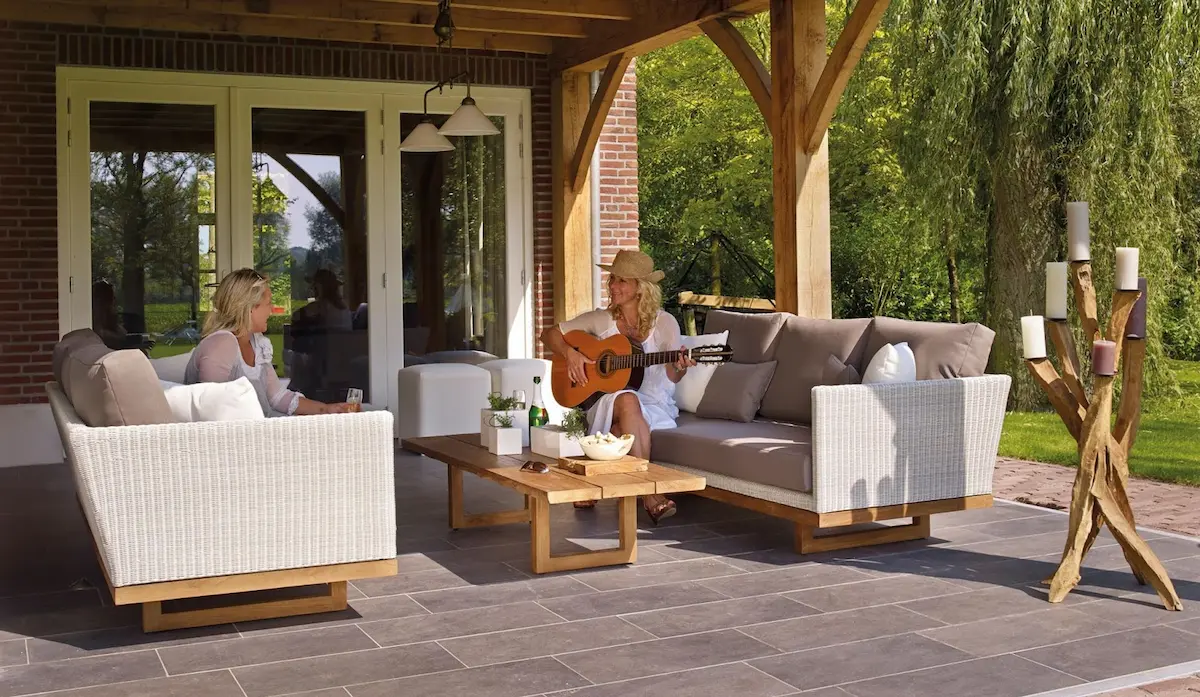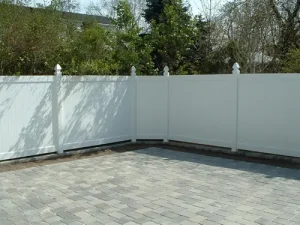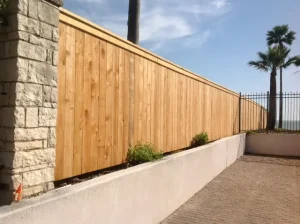![The Great Fence Debate Wood Versus Vinyl [How to Choose]](https://www.dcfence.com/wp-content/uploads/2024/04/The-Great-Fence-Debate-Wood-Versus-Vinyl-How-to-Choose-300x157.webp)
The Great Fence Debate: Wood Versus Vinyl [How to Choose?]
When it comes to enhancing the privacy, security, and aesthetic appeal of your home, few elements play as pivotal a role as your choice of

Have you ever admired a beautifully designed outdoor living space and wondered how that elegant structure made it all come together?
Chances are, you were looking at a pergola.
But what is the point of a pergola?
A pergola is a garden feature that provides a shaded walkway or sitting area supported by columns and covered with an open-raftered roof.
Pergolas have been around for centuries, and the word derives from the Latin “pergula,” which means projecting eave. These outdoor structures originated in ancient Greece and were used as shaded walkways in gardens. Over time, they have evolved into stylish architectural features that can be used to enhance any outdoor space, providing a comfortable space to relax or entertain all year round.
When it comes to designing your outdoor structure, adding a pergola can provide a significant boost in aesthetics. With their unique design, they add an element of sophistication to any garden or patio. In addition to their aesthetic value, pergolas also help create an outdoor living space that can be used for various activities. Pergolas provide a comfortable space, whether you want to entertain guests or relax in the shade with a good book. Additionally, they can complement your home’s architectural design, helping to tie together the overall look and feel of your property.
Pergolas are more than just a decorative piece in your backyard. They serve a variety of functions that can be appreciated not only by homeowners but also by those who visit their outdoor spaces.
One of the most significant functional benefits of a backyard pergola is its shade, allowing you to enjoy your outdoor space even on the sunniest days. Several shading options are available for pergolas, from fabric canopies to retractable awnings to louvered systems that allow you to adjust the angle of the shade as needed. To ensure you’re making the most of your pergola’s shade potential, it’s essential to consider factors like the sun’s angle, the orientation of your pergola, and the location of nearby trees or structures.
Finally, choosing the right material for your pergola’s shading system is key; opt for a durable, easy-to-clean, and resistant to fading or water damage. With these things in mind, you’ll be able to enjoy your shaded oasis for years to come.
Another significant benefit of installing a pergola is its ability to protect outdoor furniture and equipment from harsh elements. Direct sunlight can cause outdoor furniture to fade and become brittle over time, but the shading provided by a pergola helps prevent this. Additionally, pergolas offer an effective shield against rain, snow, and wind, keeping outdoor equipment dry and functioning. Perhaps most importantly, pergolas protect against UV damage, which can be especially important for expensive outdoor furniture and equipment.
With its sturdy framework, a pergola can be an excellent climbing support for various popular plants, such as wisteria, roses, and grapes. Along with sprucing up your yard, these plant-covered structures provide functional benefits, such as increasing privacy, reducing noise pollution, and filtering sunlight. However, maintaining the plants on a pergola can require some upkeep, such as regular pruning and watering. Still, you can create a whimsical and inviting atmosphere in your backyard with a little effort.
Whether you’re looking for a place to relax with friends and family or want to create an outdoor dining area, a pergola can be a great choice. With proper planning and the right tools, building a pergola can be a fun and rewarding DIY project that will provide you with years of enjoyment in your backyard.
There are a few factors to consider when selecting a spot, such as the amount of sun or shade you’d like, the proximity to your home, and the view you’d like to enjoy. Once you have a few locations in mind, you’ll need to decide on the placement of your pergola. Will it be attached to your home or stand alone? Will it be centered or off to one side? These decisions will impact the overall look and functionality of your pergola.
Lastly, it’s important to ensure proper drainage for this backyard space. Whether you choose to use gravel, pavers, or a French drain, this will prevent water from pooling around the foundation and causing damage over time.
When planning your pergola design, it’s essential to consider the aesthetics and the practicality of the structure. Factors such as the amount of shade and privacy desired, the type of weather in your area, and the pergola’s intended use should all be considered. Additionally, it’s important to think about how the pergola will fit in with the existing architectural style of your home and yard. Whether you choose a traditional or modern design, incorporating a pergola into your outdoor space will enhance your enjoyment of your home and the beauty of the great outdoors.
Are you looking to add charm and shade to your backyard or garden? Building a pergola is a great way to achieve both. Here is our step-by-step guide on how to build a pergola:
A pergola can provide shade and a place to hang out with family and friends and add value to your home. It’s a great way to enhance your outdoor living area and create a space that reflects your personality and style.
If you’re interested in adding a pergola to your yard, don’t hesitate to contact us at D&C Fence Co. We are happy to help build the perfect structure to fit your needs and style.
By submitting, you agree to receive emails from Uscreen and to our privacy policy.
![The Great Fence Debate Wood Versus Vinyl [How to Choose]](https://www.dcfence.com/wp-content/uploads/2024/04/The-Great-Fence-Debate-Wood-Versus-Vinyl-How-to-Choose-300x157.webp)
When it comes to enhancing the privacy, security, and aesthetic appeal of your home, few elements play as pivotal a role as your choice of

PVC (Polyvinyl Chloride) fencing is a type of synthetic plastic fence that offers a modern alternative to traditional materials like wood and metal. Distinguished by

Wood fences are one of the most traditional and versatile types of fencing used to delineate property lines, enhance privacy, and contribute to the aesthetic
Complete the form below and a representative will contact you shortly.